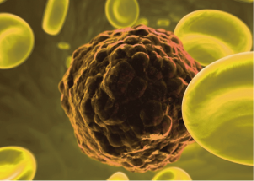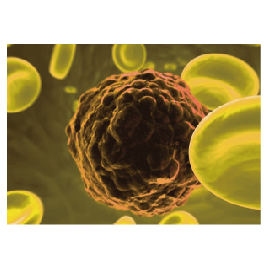Product
제품
- Tumor Marker ELISA Kit
- 제품명: Tumor Marker ELISA Kit
- 용도: Human Diseases
- 메이커: Creative Diagnostics
- 카달로그:
소개
Tumor Marker ELISA Kit
Tumor Marker Background
Cancer (malignant tumors) is a major health problem worldwide and one of the most important causes
of morbidity and mortality in children and adults. The existence of specific anti-tumor immunity implies that tumors must express antigens that are recognized as foreign by the host. Tumor markers are defined as biological molecules (proteins, peptides etc.) indicating the existence of tumors inside the organism. Tumor markers are synthesized by tumor cells or by surrounding tissue or cells as response to the tumor. ELISA test for determination and quantification of tumor markers are intended for monitoring and identification of recurrences and asymptomatic dissemination.
For many reasons, tumor marker itself is usually not enough to diagnose or rule out cancer. Most tumor markers can also be made by normal cells as well as by cancer cells. Sometimes, non-cancerous conditions can also cause elevation of some tumor markers to be higher than normal. Besides, not every cancer patient may have raised level of a tumor marker. For these reasons, only a handful of tumor markers are commonly used by most doctors. (Table 1.)
Table 1. Frequently used clinical tumor markers.
|
Tumor Markers |
Details |
|
Alpha-fetoprotein (AFP)
|
AFP is elevated in hepatocellular carcinoma of liver and is useful to monitor response to treatment. AFP is also elevated in certain testicular cancers (embryonal cell & endodermal sinus types).
|
|
β-2microglobulin (B2M)
|
Elevated in multiple myeloma, chronic lymphocytic leukemia & some lymphomas. Patients with higher levels of B2M usually have a worse prognosis. B2M is also often elevated in chronic renal failure and dialysis patients without cancer.
|
|
CA15-3
|
CA 15-3 can be used to monitor breast cancer patients. Elevated blood levels are found in <10% of patients with early disease and in about 70% of patients with advanced disease. CA 15-3 levels usually drop following effective treatment. But CA 15-3 can also be elevated in other cancers & in some non-cancerous conditions such as benign breast conditions & hepatitis.
|
|
CA27.29
|
CA 27.29 is another marker to monitor breast cancer patients. This test measures the same marker as CA 15-3 but in a different way & does not appear to be any better in detecting early or advanced disease. It can also be raised in other cancers and in some non-cancerous conditions.
|
|
CA125
|
CA 125 is the standard tumor marker to follow patients with epithelial ovarian cancer during or after treatment. >90% of patients with advanced ovarian cancer have elevated CA 125. Because about half of ovarian cancer patients with elevated CA 125 still have tumor confined to the ovary, CA 125 is being studied as screening test for ovarian cancer. CA 125 can also be raised in patients with endometrial and pancreatic cancer as well as in benign conditions such as endometriosis, pelvic inflammatory disease and benign ovarian cysts.
|
|
CA72-4
|
CA 72-4 is a newer test being studied in ovarian, pancreatic and stomach cancer. Studies of this marker are still in progress.
|
|
CA19-9
|
CA 19-9 is considered the best tumor marker for following patients with pancreatic cancer. A high level in a newly diagnosed patient usually means advanced disease. CA 19-9 is not used as a screening test because usually it will not detect early disease. CA 19-9 may also be used to monitor colorectal cancer, but because it is less sensitive than CEA test, most would recommend CEA. CA 19-9 can also be raised in other cancers such as stomach and bile ducts cancer and in some non-cancerous conditions such as pancreatitis.
|
|
Carcinoembryonic antigen (CEA)
|
CEA is the preferred tumor marker to monitor patients with colorectal cancer during treatment, but it is not useful as a screening or diagnostic test. The higher the CEA level at time of diagnosis, the more likely it is that the disease is advanced. CEA can also be raised in cancer of lung, breast, thyroid, pancreas, liver, stomach, ovary and bladder. It can also be elevated in non-cancerous diseases and in chronic smokers.
|
|
Chromogranin A (ChgA)
|
Blood level of ChgA is raised in patients with neuroendocrine tumors such as carcinoid tumors, neuroblastoma, small cell lung cancer and some rare cases of prostate cancer that have neuroendocrine features. ChgA is probably the most sensitive tumor marker for carcinoid tumors: level raised in 1/3 of patients with localized disease and 2/3 with metastatic disease.
|
|
Neuron -specific enolase (NSE)
|
NSE, like Chromogranin (ChgA), is a marker for neuroendocrine tumors such as small cell lung cancer, neuroblastoma and carcinoid tumors. NSE is more useful in follow-up of patients with small cell lung cancer or neuroblastoma, while ChgA seems to be a better marker for carcinoid tumors. NSE is not used as a screening test. Elevated level can also be found in some non-neuroendocrine cancers.
|
|
HER2 (also known as EGFR 2)
|
About 25% of patients with breast cancer have tumors that overexpress HER2, which is associated with aggressive disease, poor clinical outcomes and shortened overall survival. Samples of tumor tissue (not blood sample) are used to test for HER2 status.
|
|
Prostate-specific antigen (PSA)
|
PSA is a tumor marker for prostate cancer. It is the only marker used to screen for a common type of cancer: prostate cancer (although some medical groups do not recommend its use). For details, please refer to Prostate Cancer Screening Guideline. Apart from prostate cancer, PSA level can also be raised in patients with benign prostatic hyperplasia, elderly men and those with larger prostates.
|
|
Prostatic acid phosphatase (PAP)
|
PAP is another test for prostate cancer which was used before PSA test was developed. It is rarely used now because PSA is much more sensitive.
|
|
S-100
|
S-100 is a protein found in most melanoma cells. Tissue samples of suspected melanoma are often tested for this marker to aid diagnosis. Some studies have shown that blood levels of S-100 are raised in most patients with metastatic melanoma. Thus this test is sometimes used to look for spread of melanoma before, during or after treatment.
|
|
TA-90
|
TA-90 is a protein found on surface of melanoma cells. Like S-100, serum level of TA-90 can be used to look for spread of melanoma. Its role in monitoring melanoma is being studied and it is not widely used at present.
|
Tumor markers may be used to help diagnose cancer, predict and monitor response to treatment and determine whether cancer has recurred after treatment. In general, tumor markers alone cannot be used to diagnose cancer, they must be combined with other tests. Studies are being done to determine if tumor markers can be used in early detection and diagnosis of cancer.
How Are Tumor Markers Used?
1. For Screening and Early Detection of Cancer
Screening refers to looking for cancer in people who have no symptoms of the disease, while early detection is finding cancer at an early stage. Although tumor markers were first developed to test for cancer in people without symptoms, very few tumor markers have been found to be helpful in this way because most tumor markers have not been shown to detect cancer much earlier than they would have been found otherwise.
2. Diagnosing Cancer
In most cases, cancer can only be diagnosed by a biopsy and tumor markers are usually not used to diagnose cancer. However tumor markers can help determine if a cancer is likely in some patients. It can also help diagnose the origin of the cancer in patients presenting with advanced widespread disease.
3. Determining the Prognosis for Certain Cancers
Some newer tumor markers help to assess how aggressive a cancer is likely to be or even how well it might respond to certain drugs.
4. Determining the Effectiveness of Cancer Treatment
One of the most important uses for tumor markers is to monitor patients being treated for cancer. If the initially raised tumor marker level goes down with treatment, it indicates that the treatment is working and is having a beneficial effect. On the other hand, if the marker level goes up, then the treatment is probably not working and change of treatment should be considered.
5. Detecting Recurrent Cancer
Markers are also used to detect cancers that recur after initial treatment. Some tumor markers can be useful once treatment has been completed and with no evidence of residual cancer left. These include PSA (for prostate cancer), HCG (for gestational trophoblastic tumors & germ cell tumors of ovaries & testicles), and CA 125 (for epithelial ovarian cancer).

